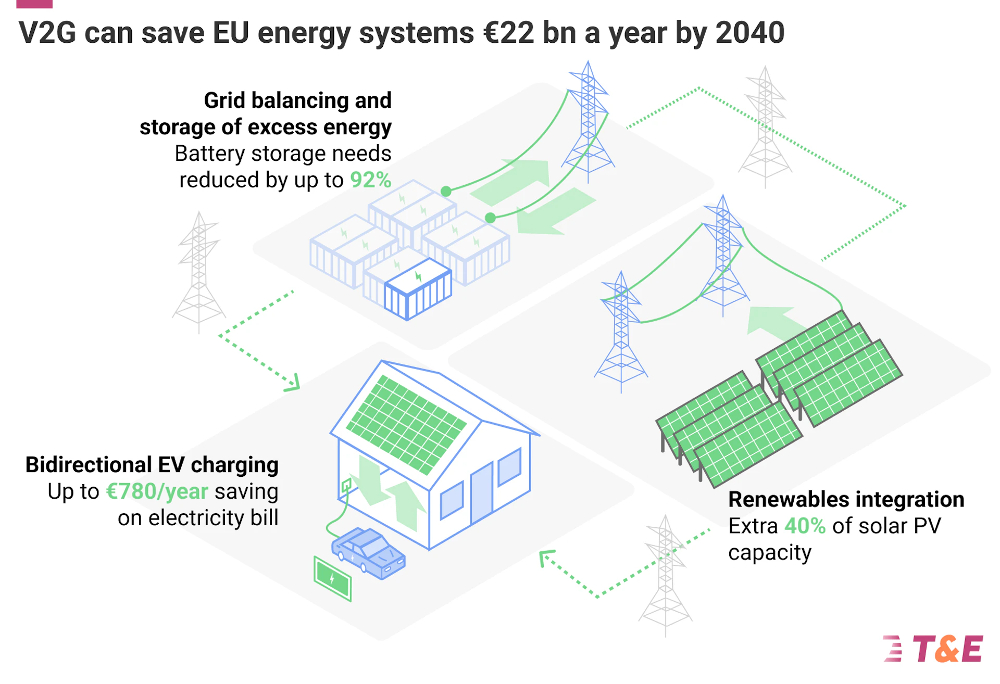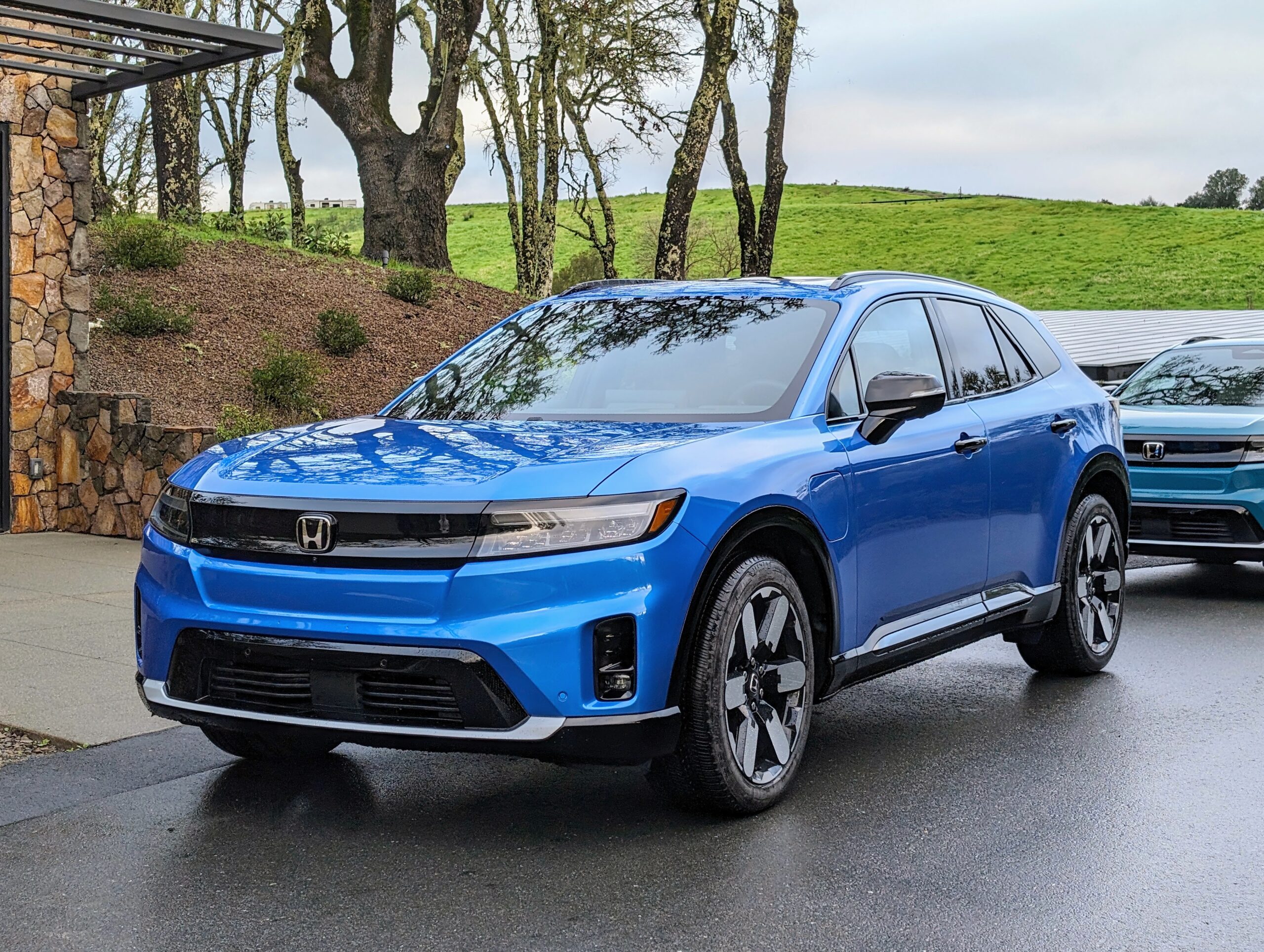Sign up for daily news updates from CleanTechnica on email. Or follow us on Google News!
Transport & Environment recently asked Germany’s highly respected Frauhhofer Institute to investigate the economic benefits of widespread V2G (vehicle to grid) technology in Europe. At the end of October, the organization issued a report, which found V2G has the potential to save Europeans up to $22 billion a year in utility costs by 2040, and more than $100 billion between 2030 and that date. Initially, the savings would be modest, as the technology would first be adopted on a small scale, but they would increase year by year as it becomes widely available. Here is a portion of that report:
The electrification of the mobility sector leads to an increase in electricity demand, and therefore to a larger demand for renewable energy generation, if CO2 emission reduction goals are to be realized. Furthermore, this can result in a greater dependency on electricity network expansion if the best renewable locations across Europe are used. Smart charging and bidirectional charging technologies offer significant benefits in alleviating pressure during this transformation. They contribute to a decrease in curtailment and electricity network expansion, facilitate better integration of photovoltaic capacity, allowing more capacity to be installed and reduce the need for alternative flexibility resources within the system.
This leads to less reliance on stationary battery storage, electrolysis and the electrification of hydrogen and natural gas. System cost savings of more than 10 percent can be realized, if smart and bidirectional charging is implemented. In the decade from 2030 to 2040, the cost difference could be over €100 billion in energy system costs, if relative savings of 2030 are used. Compared to smart charging alone, bidirectional charging offers additional advantages, such as decreasing the need for backup capacity from gas and hydrogen power plants and lowering the use of power generation from these sources.
The opportunity to integrate PV capacity more effectively is seen as the biggest value of the charging flexibility provided by electric cars, especially when they are connected during the day. This represents a key advantage of electric cars over the charging flexibility of trucks that charge mainly at nighttime. This is the reason why the flexibility of trucks adds only marginal value to the power system (if passenger cars are already equipped with bidirectional capabilities). Consequently, the additional value of bidirectional charging decreases with a larger share of electric vehicles. The modelling results indicate that a large part of the benefits of bidirectional charging can be realized even without truck flexibility.
V2G Benefits
Transport & Environment says those potential cost reductions are due to EVs helping to accommodate the transition to renewable electricity on grids. EVs plugged in at home or work can reduce the need for stationary battery storage by up to 92% in 2040. With V2G, Europe’s grid could integrate up to 40% more solar energy capacity. By storing excess renewable energy that would otherwise be lost, Europe’s EV fleet could contribute up to 9% of the EU’s annual power needs by 2040. This would make EVs the fourth largest electricity “supplier” in the EU and reduce the need for additional generation capacity.
Fabian Sperka, vehicles policy manager at Transport & Environment, had this to say about the Fraunhofer report: “Electric vehicles have put road transport on the path to decarbonization, but they have more economic benefits yet to be realized. Bi-directional charging will offer batteries on wheels for free, reducing the need to build energy storage for excess wind and solar power.”

By allowing EVs to charge with excess electricity when it’s cheap or from home solar panels, bidirectional charging could save EV drivers up to 52% on annual electricity bills, according to the study. This would equate to reductions of up to €780 a year, depending on factors such as location, whether their house has solar panels, and their vehicle’s battery size. Bidirectional home chargers are expected to cost about €100 more than conventional residential charging equipment. Would you spend €100 to cut your utility bill by half? Oh, you betcha!
Bidirectional charging can also extend the life of EV batteries due to regular charging and discharging according to a study published in the journal Science Advances in May of this year. Battery lifetimes could be extended by up to 9% compared to standard EV charging practices, the report finds, as the car is maintained in an optimal state of charge.
Standards Matter
Europe can reap the benefits of V2G technology almost for free, as the additional costs of bidirectional onboard chargers and residential chargers would be offset by reduced electricity bills within a few months. However, as different car manufacturers are currently focusing on either AC or DC bidirectional systems, the lack of interoperability is holding back the adoption of V2G. According to Fabian Sperka, “V2G can only take off if we ensure all EVs can work with all chargers. Lawmakers can unlock the potential of this technology by deciding the EU standards for bidirectional charging. That will be a win for consumers, the environment and progress towards the EU’s climate and energy goals.”
The requirements for V2G vary considerably in some EU countries. Germany, for example, has a decentralized electricity grid with over 900 grid operators, which naturally makes the implementation of innovative technologies more difficult. In countries such as France and the UK, on the other hand, the number of operators is in single figures. In addition, regulatory hurdles still need to be removed in Germany — in particular the double grid fees. Another issue is the sluggish smart meter rollout, which is developing a completely different dynamic in other countries, according to Electrive.
Transport & Environment considers it a problem that the automotive industry currently relies on different technical approaches — some AC based and some DC based — which could make interoperability considerably more difficult in the long term. This situation is similar to the great EV charger plug debate in the US where CCS competed with CHAdeMO for years and then with the NACS standard developed by Tesla until a decision was made to adopt the NACS standard, which is now known as SAE standard J3400. While that is an important step forward for EV drivers in America, it took years for that decision to be made and it will take years before every EV in the US is using that standard. The upshot is that standards matter and the sooner they are adopted, the better for all concerned.
Renault & V2G
As we reported recently, the new Renault 5 EV will have V2G capability baked in from the start of production. On October 22, 2024, Mobility House announced a new partnership with Renault that will allow the R5 to share power with the electrical grid, in addition to its existing vehicle-to-load capability that can provide up to 3500 watts of electricity to operate power tools and campsites. In a press release, the company said, “With the V2G product Mobilize Power, car batteries are being intelligently integrated into the power grid for the first time in France in a commercial and scalable product for end customers. This marks the beginning of a new era in which electric vehicles not only consume energy but also return it to the grid, thus becoming storage power plants. The UK will follow in 2025, while Germany continues to evaluate and develop its approach to implementing V2G technology. Thanks to The Mobility House and Mobilize, V2G is now becoming a reality for many end customers, with great advantages for customers and social benefits.”
Thomas Raffeiner, founder and CEO of The Mobility House, said his team has broken new ground since the company was founded in 2009. “With the launch in France, we have reached an important milestone that proves that we are technically capable of successfully implementing V2G. Now we need to show that it is possible to drive an electric car free of charge and with zero emissions in Germany too.” France has only one major distribution grid operator, which makes the integration process simpler.
At the heart of The Mobility House V2G platform is an EV aggregation platform which the company uses to market its customers’ aggregated charging flexibility on various electricity markets. Technically, it is very sophisticated stuff, but for the EV owner, it simply means that the stored electricity in the battery of an electric car can become a potential revenue stream. That is the business model of the future. Whereas a thermal generating station can provide a constant and predictable supply of electricity as long as it has fuel, renewables have a variable output. That doesn’t make renewables any less valuable as sources of grid-scale electricity; it just means they need different management strategies. V2G control systems may become an important part of those strategies.

Chip in a few dollars a month to help support independent cleantech coverage that helps to accelerate the cleantech revolution!
Have a tip for CleanTechnica? Want to advertise? Want to suggest a guest for our CleanTech Talk podcast? Contact us here.
Sign up for our daily newsletter for 15 new cleantech stories a day. Or sign up for our weekly one if daily is too frequent.
CleanTechnica uses affiliate links. See our policy here.
CleanTechnica’s Comment Policy




